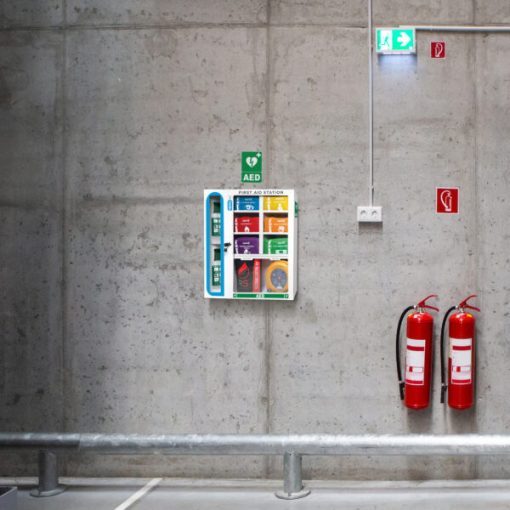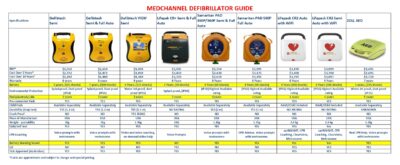Top Defibrillator Models Compared: Find the Best Fit for Your Needs

First Aid AE takes a look at Top Defibrillator Models Compared in this article. Choosing a defibrillator (AED) is a significant decision for any organisation or individual. Whether you are purchasing one for the first time, looking to upgrade your current device, or needing a replacement because your existing defibrillator is nearing expiry, it’s essential to understand the differences between popular models. As a professional first aid product provider and defibrillator expert, we at First Aid Accident & Emergency aim to guide you in making an informed choice bewteen the top defibrillator models compared. Below, we’ll compare three key defibrillator models, without bias, so you can find the best fit for your needs and environment.
Disclaimer: The information in this article is designed to be general in nature and not a substitute for formal medical advice or official guidelines. Always consult healthcare professionals or trained first aid instructors when making decisions about medical equipment and procedures. You can reach our experts on 07 5520 5068.

Why Owning a Defibrillator Is Essential
The Life-Saving Potential of Early Intervention
Sudden Cardiac Arrest (SCA) can happen to anyone, anywhere, and at any time, even in people with no known history of heart issues. Statistics indicate that survival rates decrease by up to 10% for every minute that passes without defibrillation. An Automated External Defibrillator (AED) can substantially increase a patient’s chance of survival if used promptly, often in conjunction with effective cardiopulmonary resuscitation (CPR).
For workplaces, community organisations, and private owners, having a defibrillator on-site means you are prepared for these emergencies. This readiness can make a life-saving difference in the critical minutes before professional help arrives.
Legal and Ethical Responsibilities
In many regions, businesses and public facilities are encouraged, or even required, to have certain first aid measures in place, particularly if large numbers of people are present or if employees work in higher-risk environments. While regulations vary, providing a safe environment is both a legal responsibility and an ethical commitment to your staff, clients, or visitors.
Peace of Mind for Your Organisation
Beyond legal obligations, owning a defibrillator offers peace of mind. If an emergency occurs, you and your team can respond immediately. The presence of an AED demonstrates a proactive, caring approach to health and safety, which can be an invaluable reassurance for employees, customers, and community members alike.

Key Considerations Before You Buy
Before exploring individual models, it’s essential to understand what to look for in a defibrillator. Different settings, user needs, and budget constraints require careful evaluation.
1. Ease of Use and Training Requirements
A defibrillator should ideally be user-friendly, especially for those who are not medical professionals. Look for devices with:
- Clear Audio Prompts: Step-by-step voice instructions are crucial, particularly in a high-stress situation.
- Visual Indicators: Diagrams and flashing lights can guide the user through pad placement and shock administration.
- Automatic vs. Semi-Automatic: In a fully automatic model, the device will administer the shock without the user pressing a button (after analysing the heart rhythm), while a semi-automatic model requires the user to press a button to deliver the shock once the device advises it.
- Shock Delivery Capacity: The Australian Resuscitation Council recommends a minimum of 200 joules and studies show rescuers may need to escalate up to 360 joules if shocks at a lower dose fail.
2. Durability and Environmental Suitability
If your defibrillator will be placed in a school gym, outdoor sports club, or industrial setting, consider features such as:
- Rugged Construction: Ensures the device can withstand drops, impact, and vibrations.
- IP Rating: A higher Ingress Protection (IP) rating indicates better protection against dust and water ingress.
3. Maintenance and Ongoing Costs
Defibrillator ownership extends beyond the initial purchase:
- Battery Life: Longer battery life and built-in self-tests can reduce maintenance.
- Pad and Battery Replacement: Check how often the pads and battery need replacement and their cost.
- Warranty: Compare warranty lengths and inclusions, as these can differ significantly between manufacturers.
4. Overall Value for Your Budget
While it’s tempting to focus solely on upfront costs, consider how each device’s features, durability, and ongoing maintenance expenses will factor into its total cost of ownership. Some higher-priced devices might offer lower long-term costs due to extended warranties, cost-effective replacement parts, or unique features that reduce maintenance.
Top Defibrillator Models Compared
Below are four popular defibrillator models suitable for various settings. Each has its own strengths, so you can choose based on your environment, user familiarity, and future needs. We do not recommend one specifically over another, as the “best” choice will differ depending on your specific situation.
HeartSine Samaritan-PAD 360P
Key Features
- Fully Automatic Operation: The device delivers a shock if needed, without additional user intervention.
- Compact and Lightweight: Ideal for environments where storage space might be limited, or for mobile medical responders.
- Audible and Visual Prompts: Guides the rescuer through pad placement, CPR timing, and shock delivery.
Ease of Use
- Minimal Buttons: Essentially, the 360P focuses on simplicity, with one main button to power on. Once the device detects a shockable rhythm, it automatically administers the shock.
- Clear Instructions: Voice and visual prompts reduce confusion and guide even inexperienced users effectively.
Maintenance Essentials
- Long Battery and Pad Life: The HeartSine “Pad-Pak” combines the battery and electrode pads into one cartridge, simplifying replacement.
- Regular Self-Checks: Conducts self-tests to ensure readiness, minimising the frequency of manual checks.
Ideal Environments
- Small businesses, community centers, and organisations looking for a straightforward solution.
- Great for those with minimal storage space and a desire for streamlined maintenance.
ZOLL AED Plus
Key Features
- Real-Time CPR Feedback: The CPR-D-padz have a sensor that measures compression depth and provides live feedback such as “Push Harder” or “Good Compressions.”
- Robust Design: Durable, making it a suitable choice for various community or workplace settings.
Ease of Use
- Text and Voice Prompts: Rescuers are guided step by step, which can help maintain composure during stressful situations.
- Visual Icons: Displays images to aid correct pad placement and highlight the next step in the rescue process.
Maintenance Essentials
- CPR-D-padz Shelf Life: Typically around five years, which can be cost-effective over time.
- Battery Life: A set of lithium batteries can last up to five years under normal conditions.
Ideal Environments
- Facilities where comprehensive CPR support is essential, such as workplaces with varying skill levels in first aid.
- Suitable if you prioritise a device that actively coaches rescuers on proper compression technique.
LifePak CR2 Defibrillator
Key Features
- CPR Insight Technology: Allows chest compressions during ECG analysis, reducing interruptions and potentially increasing CPR effectiveness.
- Child Mode Button: Instantly reduces the energy level for pediatric use without needing special pads.
Ease of Use
- Clear Voice Guidance: Step-by-step instructions help guide lay rescuers.
- Simple Design: The device focuses on easy operation, with minimal steps to reduce confusion.
Maintenance Essentials
- Connectivity Options: Where available, some CR2 models offer Wi-Fi connectivity that allows you to track the device’s status remotely.
- Status Indicators: Regular self-tests ensure the defibrillator is rescue-ready. When attention is needed, the device provides clear alerts.
Ideal Environments
- High-traffic areas such as airports, shopping centers, and large corporate offices.
- Organisations looking for advanced technology and minimal downtime in a busy setting.
Additional Tips for Choosing the Right Defibrillator
1. Assess Your Location and Environment
- Indoor vs. Outdoor: If you plan to install the AED outdoors or in an environment exposed to the elements, consider a waterproof cabinet or a device with a high IP rating.
- Frequency of Use: High-traffic areas might benefit from features like connectivity for regular status checks, ensuring the device is always ready.
2. Prioritise Training and Familiarity
Even the most advanced AED is only as effective as the person using it. Consider scheduling training sessions for all staff, volunteers, or community members who may need to operate the device. Regular refresher courses can keep everyone’s knowledge up to date.
3. Plan for Future Needs
- Children or Pediatric Use: If your environment includes children, look for features such as pediatric pads or a dedicated child mode.
- Software Upgrades: Some defibrillators offer online software updates, ensuring your device remains compliant with the latest guidelines.
4. Budgeting for the Long Run
- Replacement Parts: Pads and batteries will expire. Factor these replacement costs into your budget.
- Warranty Options: A more extended warranty can save on repair costs and ensure quicker support, but always read the terms carefully to see what is covered.
- Financing Plans or Packages: If budget is a concern, some providers offer packages that include service checks, replacement parts, or training sessions.
Ensuring Compliance with Health and First Aid Regulations
Always stay informed about relevant local regulations and laws concerning defibrillator ownership and placement. Some jurisdictions may require you to:
- Register your AED with local emergency services.
- Conduct regular checks and maintain written documentation of each inspection.
- Ensure signage is visible so staff and visitors can quickly locate the device.
- Provide accessible training for employees and volunteers, ensuring they can competently use the AED if needed.
Maintaining compliance goes beyond ticking boxes. It’s also about ensuring that your life-saving equipment is ready to perform when every second counts. In addition, abiding by these guidelines can protect organisations and individuals from legal complications.
Find the Best Defibrillator for Your Needs – Top Defibrillator Models Compared
Selecting the right defibrillator is a process that should involve considering your specific environment, user expertise, and budget constraints. All four models discussed — HeartSine 360P, ZOLL AED Plus, LifePak CR2 — have unique attributes suited to different scenarios. Whether you’re looking for simplicity, advanced monitoring capabilities, robust durability, or intuitive CPR coaching, there is a device that can fit your requirements.
Purchasing a defibrillator is a crucial step in protecting the people around you whether they are employees, community members, or loved ones. Having an AED on-site can make the difference between life and death in a cardiac emergency, and ensuring you pick the right model can streamline the rescue process.
Need more help deciding between the Top Defibrillator Models Compared here? Call us on 07 5520 5068. Our experts can help you find the right defibrillator for you! Find us on Google Maps.
 Construction Defibrillator Bundles
Construction Defibrillator Bundles